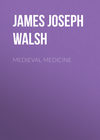Kitabı oku: «Psychotherapy», sayfa 4
CHAPTER II
UNCONSCIOUS PSYCHOTHERAPEUTICS
The great authorities in medicine, the men whose thought counted for most in the development of not only the science but the art of medicine, the men to whom we look back as having been great practicing physicians, have always used this remedial measure deliberately and have suggested to others that it should be so used. But the smaller minds have been satisfied to think that their drugs, their external remedies and applications, have been the sole sources of the benefit that accrued to the patient. Such smaller men are prone to think that they have specifics for disease, while the larger men hesitate and recognize that coincidence plays a large role and that the suggestive factors in therapeutics often deceive us as to the real efficacy of drugs and remedies.
All physicians have at all times used, though often unconsciously, the suggestive factor in therapeutics, and mental influence has had everywhere a large role in the treatment of disease. Only in recent years have we come to appreciate how many diseases are self-limited. In the treatment of these self-limited diseases all sorts of drugs and therapeutic methods achieved a reputation. Some of them were looked upon by generations as specifics, though we know now that they are almost, if not completely, useless so far as any direct influence upon the disease is concerned. Indeed, at times they were, per se, harmful rather than beneficial, and the patient literally got well in spite of the treatment, though the repeated suggestion of betterment often more than overcame the ill effect and helped in recovery.
REMEDIES PLUS SUGGESTION
Prof. Richet, the head of the department of physiology, University of Paris, quotes the expression of a French critic of medicine: "Hurry up and take the new remedy while it still cures. After a time it will lose its power." The power that is lost as remedies grow familiar is the suggestive element that accompanied them at the beginning. They were announced with a flourish of trumpets as a discovery in therapeutics, a number of cases treated with them were much benefited (because of the feeling that they must do good), and it was only after a great many cases had been treated, many of them under circumstances where patients knew nothing of the claims made for the remedies, and where physicians had little or no previous confidence in them, that their true place in therapeutics was revealed. Every physician of experience has seen the popularity of remedies wax and wane as a consequence of the attention called to them. We have new therapeutic discoveries every week. Enthusiastic articles are written about them, many of them in perfect good faith, and then after a time no more is heard of them, or they sink back into the long list of dubious remedies that may be tried when others have failed, but have no special claim upon us, in spite of the fact that some physicians continue to think them wonder-working.
"Time is short and art is long, the occasion is fleeting, experience fallacious and judgment difficult," as Hippocrates bemoaned 2400 years ago, and conditions in medicine continue the same. With suggestions and coincidence ever at work, it is still practically impossible to determine the intrinsic value of any remedy until after a prolonged trial. In the olden time it was still more difficult because there had been no such accumulation of experience as we have to guide us, and so it is not surprising to find striking examples of even great physicians recommending remedies whose main therapeutic influence must have been the element of suggestion.
Galen's Theriac.—Perhaps the most striking instance of suggestive therapeutics is Galen's famous theriac, various prescriptions for which have come down to us, some of them much more complex than others, so Galen is probably not responsible for all its absurdities. This remedy contained a host of ingredients, some of which neutralized others, and all of which taken together could have had but little effect save by a strong suggestion to the patient that as he was taking so many drugs he surely must be benefited.
Bernard's Theriac.—Almost in our own time another theriac came prominently before the public. In his younger years Claude Bernard, the French physiologist, worked in a little drug store in a country place not far from the farm on which he was born. There he found that the most called for remedy was a theriac. It was good for most of the ills that flesh is heir to and was bought in quantities by the old women of the neighborhood, who administered it on every occasion. The remedy was made in large quantities, but the secret of its composition in this particular pharmacy was what interested Bernard. Whenever any compound was for any reason spoiled in the drug store, the rule was, "Put that aside for the theriac." This much sold remedy then consisted of the most heterogeneous drugs. It was so diluted that it could do no harm, though it had quite sufficient taste and odor to make every one who took it realize that without doubt they were taking a strong medicine.
The effect of the knowledge of the composition of this wonderful remedy on Claude Bernard was the best that could have been anticipated. He resolved to study the physiological effects of drugs so that they could be given scientifically, and not in the hit or miss fashion that made possible the success of the theriac.
The custom of Bernard's country drug store, however, was not different from that of most country drug stores of the time. Unconscious psychotherapeutics we may well call it, because the main therapeutic factor was suggestion, renewed as often as the mixture was taken, that the patient ought to feel better, until finally whatever symptoms were due to over-attention and to concentration of mind on feelings of discomfort were diverted. Just as soon as the inhibition exercised by this over-attention ceased its hampering effect nature completed the cure.
Suggestion in Colds.—Many remedies acquired a reputation for breaking up coughs and colds. It is, however, extremely doubtful whether any one has ever aborted a cold, or any other infection, that had gained a hold on the patient. We now know that this common affliction is not due to cold but to absorption of infectious material. Nansen spent two winters near the North Pole without catching any cold, and his men were as healthy as himself. He had been back in civilization scarcely a week before he and his men were confined to bed with a grippy cold. In the far north, and high on mountains where the temperature is low, colds are not as common as they are in crowded cities and especially among those who are much in crowds. Cold weather only predisposes to the infection, and after it has occurred it is sure to run its course. That course may be longer or shorter. The cold is usually preceded by chilly feelings. Every one knows it is possible to have chilly feelings that seem to portend a cold, yet be well the next day. If in the meantime any remedy is taken, credit will be given to the remedy. When a cold was supposed to be merely a disturbance of circulation or a congestion, one might expect to break it up. Now that we know that it is a microbic infection, and know further that microbic diseases are usually cured by a definite reaction on the part of the body, we are not so likely to think of breaking them up. There are still physicians who think they can abort a threatened pneumonia or abbreviate typhoid fever, but they are not those who know most about the science of medicine.
We have the story, then, of a series of remedies used with great confidence in coughs and colds, some of them physically beneficial, many of them, especially those containing opium, often physically harmful, yet taken with such confidence that undoubtedly the patient was helped through his mind if not otherwise. What is thus true for this class of diseases can also be said of other minor affections. Many internal remedies have been used for boils and styes and other external infections and have often had wide vogue. The reason for their acceptance as remedies has been that the giving of anything produces a more hopeful attitude in the mind of the patient and this, by bettering the general health, sometimes overcomes the tendency that may exist to a repetition of such infectious processes.
Erysipelas.—The medical history of erysipelas is just a succession of remedies recommended, each claimed to be almost infallible, yet abandoned after a time for another for which like exaggerated claims were made. The doctrine of signatures played a large rôle in the treatment of erysipelas, and, strange as it may seem, still survives. According to the doctrine of signatures, erysipelas, being a disease involving intense redness of the skin, red things in nature would be likely to do it good. Red pepper, for instance, was suggested for it over and over again, both internally and externally. Various red remedies have been favorites at different times in history. At present, in many country places, a poultice made of cranberries is supposed to be most efficacious. For many years I lived in a small town where one of the grocers put in a large stock of cranberries each fall, though the people of the neighborhood used them but little on the table, because during the winter there were many calls for them for the making of poultices for erysipelas. People who have had erysipelas, especially if it has occurred on unexposed portions of the body, are supposed to be protected against its recurrence—for there is a distinct liability to its recurrence—by the wearing of red flannels!
There is scarcely any drug that has not at some time been recommended as almost a specific for erysipelas. Anything that was given on the third or fourth day, and it was only at this time as a rule that patients came to physicians to be treated, seemed to bring about the alleviation of symptoms that occurred on the fifth or sixth day.
Erysipelas, because of the sudden irruption of fever which accompanies it, the intense redness which characterizes it, and the discomfort which is often present, is an affection that disturbs patients very much. For them, then, the presence of the physician and his assurance that their affection is not likely to be severe, and his prompt relief of certain conditions, all act by suggestion on the patient's mind and strengthen the natural curative reaction.
In country places where physicians were not near, erysipelas was one of the affections that continued almost down to our own day to be treated by incantations. I have known in a little American country town of a woman making a "charm," as it was called, for erysipelas.
Pneumonia.—Pneumonia is another of these sharply self-limited diseases that give opportunity to many remedies for the acquisition of a reputation as cures. Croupous pneumonia is so disturbing in its onset, so rapid in its progress, yet so strictly self-limited in the previously strong and healthy, that in the old days there were many remedies that were supposed to bring about the crisis. The old text-books contain so many cures that it is surprising pneumonia should have continued to be the fatal disease it has been at all times. Almost any remedy that is used for three or four days in pneumonia will be followed by the crisis with, in most cases, a favorable termination. The crisis takes place some time from the seventh to the tenth or eleventh day, and often we do not see a pneumonia patient until the second or third day of the disease. Just before the crisis the patient runs into a series of acute and more or less alarming symptoms. Often there is much restlessness, difficulty of breathing with complaint of heaviness, and perhaps prostration. The pulse and temperature are high, the skin hot and dry. Then in the midst of this the patient sleeps, there is a critical sweat, the temperature drops, the patient wakes up feeling quite well, there is little difficulty in breathing, and he feels that recovery is sure to come. The change is so great that it is natural that it should have been attributed to all sorts of remedies which had been used immediately preceding the crisis.
I once heard an old physician declare at a meeting of a large and important medical society that calomel in divided doses was practically a specific for pneumonia. He said he waited forty-eight hours to be sure that the affection was pneumonia, and also that it had reached that diffusion in the lungs beyond which it was not likely to go, then he gave the calomel. He said that, almost as a rule, during the next forty-eight hours the crisis came—and he attributed it to the calomel. We have had other remedies just as curious as this recommended and taken quite seriously. Some years ago a Russian physician, who had been treating soldiers in the Russian army for the pneumonia which occurs so commonly after exposure on the Steppes, announced that he had found in digitalis almost a specific. He pushed the tincture up to twenty drops three times a day, beginning it just as soon as the pneumonia was detected, and the rate of mortality among his patients was about one per cent. According to his theory, it was the failure of the heart in pneumonia that made the disease fatal.
Apparently the character of the patients in whom his pneumonias occurred was forgotten. They were absolutely the most favorable cases that could be selected. Most of them were young men between twenty and twenty-five. At this age no one who is given a reasonable amount of fresh air should die of pneumonia. If the patient had a serious heart lesion, or a crippled kidney from nephritis after scarlet fever, or crippled lungs because of a previous attack of tuberculosis, then the pneumonia might be fatal—indeed, almost inevitably would be, or, in the last-mentioned case, would end by lysis and not crisis. It really matters little what remedy is given to young, otherwise healthy, adults; they will get better, barring serious complications. The use of digitalis lessened the chances of recovery by stimulating too early in the case the heart that later had to bear one of the most serious strains that the organ can stand. But doubtless this harm was more than overcome by the patient's knowledge that he was taking a new and powerful remedy, supposed to be particularly calculated to cure him.
Moreover, the special interest of the physician in these cases, and his administration of a remedy with confidence which inspired the patient, undoubtedly did much good. Pneumonia is one of those diseases in which the patient is likely to be greatly depressed unless he is surrounded by favorable mental influences, and is encouraged to believe that he is going to get well. Every physician has probably had cases in which patients died, not because of the severity of the disease, but because they gave up the struggle in fright. If several of a man's friends have died of pneumonia during the year or two before he gets it, he is likely to conclude, especially if he is of the worrying kind, that his doom is sealed as soon as the diagnosis of pneumonia is made. If this thought persists hardly anything will save him. He must be assured that pneumonia is not necessarily serious, that there are remedies that influence it, and that his own case is particularly likely to respond favorably to them.
We now realize that nursing is the most important element in the treatment of pneumonia. Such attention to the patient as will treat symptoms so as to prevent them from disturbing him, will secure him against discouragement, will arouse his resistive vitality by assuring him of a favorable termination. This will above all prevent the patient from feeling that he is attacked by a fatal disease. The presence of the doctor and his general directions make the patient realize how thoroughly the course of the disease is understood and therefore how likely it is that a favorable termination will be brought about. We know how much the mind may interfere with the breathing if allowed to dwell on it, and therefore if the patient becomes over-solicitous about the condition of his lungs he seriously hampers his recovery. In pneumonia the physician has always brought relief, and he has usually attributed his success to his drugs, though he has felt, too, that the confidence inspired by him meant much for his patient. It would have been better had he exaggerated the mental influence rather than the drug power.
Typhoid Fever.—Typhoid fever is another affection for which we have many therapeutic suggestions, with wide vogue, that are nevertheless almost directly opposed to what we know about the pathology and etiology of the disease. Typhoid fever runs its course in from between twenty to thirty days. The majority of people who take the affection and who give in to it early enough, so as not to wear themselves out, come through successfully. Complications may carry them off, but we expect uncomplicated cases to recover. The longer course of typhoid has made the action of drugs appear less striking than in pneumonia and erysipelas, but a number of remedies have been proclaimed to shorten its course, to make it less dangerous, to cure, and sometimes actually to abort it. So often have these come and gone that the physician who knows the history of therapeutics is likely to be suspicious of them. Even at present there are certain remedies supposed to have this effect, but one does not find them used in hospitals where large numbers of cases are seen and where there are opportunities for comparative observation. They are used only by physicians who see a few cases every year, and to whom coincidences may mean much more than they are likely to when extensive statistics of the disease are made.
As a rule, these remedies are founded on some real or supposed scientific principle. The antiseptic treatment of typhoid, for instance, was based on the supposition that if one can kill the microbes in the intestine the disease will run a shorter course. The principle apparently fails to note that any remedy likely to kill microbes is still more likely to kill cells of other kinds, and above all human cells lessened in their resistive vitality by disease. The advocates of this remedy also forget that typhoid is now recognized as a general disease with only a local manifestation in the intestines, and that the treatment of this local manifestation is no more likely to affect the course of the disease than the treatment of the symptoms of typhoid would be likely to do. But the giving of remedies with the thoroughgoing confidence that awakens trust is in itself an excellent therapeutic agent, and patients thus treated are sure to be benefited in so far as they share the physician's confidence. Just the same effect, however, can be produced by careful nursing and by making the patient realize that even though typhoid fever runs a definite course, which we cannot abbreviate nor probably influence, we can by nursing so prevent complications as to make a fatal termination almost impossible.
Whooping Cough.—Perhaps none of the common affections illustrate the influence of psychotherapy better than it is exemplified in the history of the therapeutics of whooping cough. We have had all sorts of remedies suggested for it, and most of them have been introduced by those who had found them of great service in shortening the course of the disease, and in making the "whoop" disappear much sooner than would otherwise be the case. There have been internal and external remedies, inhalations and inunctions, as well as many less likely methods of treatment. Practically none has maintained itself. Whooping cough is likely to run a rather long course. We know now that as a consequence of the strain upon the lungs tuberculosis not infrequently develops. Whenever this is true the tendency to cough is likely to be prolonged far beyond the natural period, and from habit ingrained upon the nervous system the "whoop" is likely to continue, though there is no necessity for it. It is this secondary period of the affection that the remedies have succeeded in shortening either apparently or in fact.
Practically anything that is done for children is likely to instil the persuasion that the "whoop" should disappear. Anything impressive will arouse this favorable attitude of mind toward the affection, and hence the remedies have obtained a reputation. In the interior of many countries draughts of sea water are a popular remedy for whooping cough. Sea water, it is said, loses its efficacy if carried long distances from the shore, so the children must be brought to the seaside. In mining regions children are taken down into the mines. The experience is enough of itself, especially when talked over a good deal in the family, and when the occasion is often the first outing that the child has had for months, to bring with it such improvement in health as will enable it to suppress the whoop. If the exposure to the mine air does not bring improvement, it is said to be either because the child was not taken deep enough, or because there was no gas in the air, or the wrong sort of mine was chosen, or some other plausible excuse is advanced.
The development of scientific medicine, or at least what we are pleased to think of as more scientific therapeutics than they had in the past, has not kept us from having many and varied remedies for whooping cough, which, after being introduced on apparently good authority and apparently accomplishing many good results, have eventually been allowed to drop into innocuous desuetude. Whenever the administration of any such remedy was accompanied by strong suggestion—when the internal remedies were particularly distasteful, or the inhalations rather trying or at least sure to attract the attention of the sufferers—then good results followed. But the cures were due to the mental influences at work. In recent years various serums, including diphtheria serum, have been tried with reported good results. The giving of the injection is one of those little operations that is likely to impress itself forcibly upon the child's mind, and when given in connection with the promise, implied or explicit, of improvement it is easy to understand that there will be a tendency to lessening the frequency of the whoop, at least during the secondary periods of the disease.








